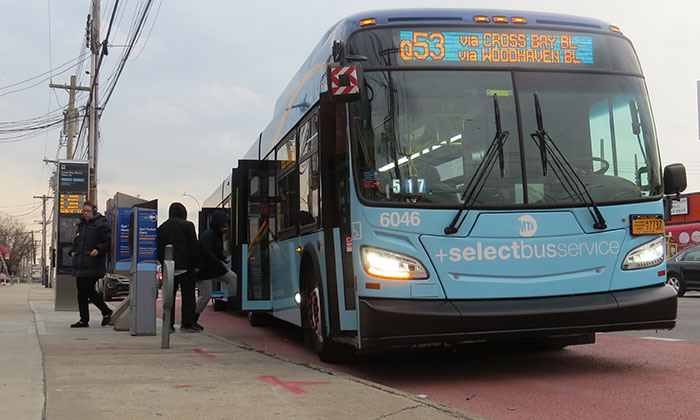File Photo
The Q52 and the Q53 use the same bus lanes along Cross Bay and Woodhaven boulevards.
By Michael V. Cusenza
The Q52, for many years a steady sight for South Queens eyes, has earned an “A” grade from a leading straphanger advocacy organization’s annual Metropolitan Transportation Authority bus route analysis.
The 52, which now leads the polarizing Cross Bay-Woodhaven Corridor Select Bus Service route, actually was the only route in the five boroughs to receive an “A” from the Bus Turnaround Coalition.
The addition of dedicated bus lanes, all-door boarding, and consolidation of stops led to a 66-percent reduction in bus bunching compared to service on the Q52 in 2017. On the Q53 SBS, which uses the same bus lanes, bunching fell 45 percent.
According to the BTC, the impact of bus lanes, all-door boarding, stop consolidation, and signal priority on SBS routes is clear to see. Overall, SBS bus are faster than local routes (8.2 mph vs. 6.4 mph) and have significantly lower bunching rates (7.9 percent vs. 11.1 percent).
These successes show that improvements are possible, but they’re too few and far between, the BTC noted. Half of all routes still got a “D.” There were 58 “F” grades, 124 “D”; 57 “C”; 8 “B”; and a single “A.”
“When bus service doesn’t make the grade, bus riders are the ones who get held back,” said Jaqi Cohen, campaign coordinator for the New York Public Interest Research G Straphangers Campaign.
Additionally, the BTC analysis shows that “New Yorkers are abandoning the bus in droves. Between 2009 and 2018, total bus ridership fell more than 17 percent, with a 4.7 percent decline in 2018 alone. Slow, unpredictable service is costing New Yorkers time with their families, making them late for work and appointments, and exacerbating the city’s gridlock as more people turn to road-clogging ride-hail services like Uber and Lyft.”
This year’s grades show some evidence of widespread improvement compared to 2017, though it may be imperceptible to most riders. In 2018, 30 fewer bus routes received a failing grade than the year before, due largely to reductions in bus bunching. On frequent bus routes, the rate of bunching declined from 14 percent to 11 percent. The MTA attributes these reliability gains to better dispatching practices that keep buses more evenly spaced.
According to the BTC’s analysis of real-time MTA data, bus speeds for the average passenger were just 6.6 mph in 2018, down from 6.8 mph in 2017. On frequent routes, where buses are scheduled to arrive at least every 15 minutes, 1 in 9 buses arrived bunched, creating frustrating, unpredictable gaps in service.
The coalition has called for more bus lanes in the city and initiatives to keep said lanes unobstructed. The group also emphasized strong coordination between the City Department of Transportation and the MTA to roll out bus lanes, transit-signal priority, all-door boarding, and redesigned bus routes as smoothly and rapidly as possible.
Full report cards for every bus route, as well as grades for all NYC legislative and community board districts, are available at the redesigned busturnaround.nyc website.

